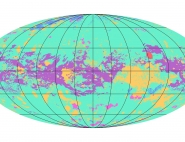Scientific Results obtained with GC-MS instrument
The main scientific results obtained from the analysis of the data are as follows:
- Concentration of the main atmospheric components, particularly nitrogen and methane, function of the altitude
- Detection of 40Ar (mixture ratio~4x10-5) and 36Ar (~3 x 10-7)
- Absence of other rare gases in any noticeable concentration
- Measurement of the isotopic ratios of the atmosphere 14N/15N = 183 (with N2) and 12C/13C = 82 (with CH4)
- Determination of condensed CH4 on the surface (vaporised by the heat transmitted to the ground by the probe)
Among the significant consequences of the results obtained, these may be highlighted:
- Increase in the methane mixture ratio below 32 km:
- towards the surface =>100% humidity from 8 km
- on the surface => presence of liquid CH4 on the surface or just below the surface (Fig. 1)
 does it rain methane? (Fig. 2)
does it rain methane? (Fig. 2)
- Non-detection of significant quantities of rare gases other than 40Ar (~4x10-5), only 36Ar was detected, but at a concentration over 100 times lower (~3x10-7)
 fundamental consequences for our understanding of the origin of Titan's atmosphere and the presence of major geological activity on the planetary body (Fig. 3)
fundamental consequences for our understanding of the origin of Titan's atmosphere and the presence of major geological activity on the planetary body (Fig. 3)
- Traces of ethane and other organic molecules (in particular cyanogen and benzene) on the surface => surface rich in organic materials (Fig. 4)
- Isotopic ratios of 12C/13C and 14N/15N: exo/astrobiological consequences, in particular the source of CH4 is most probably non-biological
- Finally, the IS2 data make it possible to analyse the structure and composition of the aerosols with ACP
![]()
Geological activity of Titan and possible origine of the methane.
![]()
Figure 4. Average mass spectrum measured on Titan's surface using direct MS. It shows that the surface must be rich in organic compounds (observation of evaporation of CH4, C2H6, C2N2 and possibly C6H6).
These results were published in the issue of Nature dedicated to the Huygens probe, in December 2005 (Niemann et al. (2005), Nature 438, 779-784). In addition, they were presented at several tens of scientific meetings and press conferences, including by the LISA team.
In parallel to these mass spectrum analyses, a study of the data from sources IS3 and IS4 (corresponding to the chromatograms in the gaseous phase of columns 1 and 2) confirms that these data are subject to a great deal of noise (high background level). The first analyses of them seem to leave little hope of extracting new useful information from them, since the quantity of material detectable via these two sources must be very high in comparison to the amount of material theoretically sampled and injected into the GC. These studies will, however, be continued so that we may identify the cause of this problem. It is in fact crucial to draw lessons from this failure in order to avoid encountering a similar problem in the development of future space GC instruments. We may, however, note that the separation of majority compounds (in this case CH4 and 40Ar) was observed in column 1 (Figure 5), confirming the results obtained during sampling carried out on the ground, which proves that column 1 was functioning properly in terms of separation after 7 years spent in space
![]()
Figure 5. Comparison of GCMS signals linked to 40Ar (in black) and CH4 (in blue) on columns 1 and 2. We may observe that with column 1, the 2 compounds are slightly separated in time, whereas with column 2, they emerge at exactly the same time, as predicted by the calibrations made on the ground.
The probable reason for the noise observed with the ionic sources IS3 and IS4 seems to be pollution of the sources by compounds external to the sources. One of the possible origins, yet to be confirmed, might be a high reactivity of the vector gas (H2) which might have reacted chemically with the materials making up the microvalves, and thereby introduced significant contamination into the columns. Another possible origin might be ageing of the stationary phase of the columns (which would be understandable after more than 7 years of interplanetary travel), which would cause a discharge of the phase material itself. However, in light of the results obtained in the laboratory on the ageing of the columns carried out n conditions close to those of the probe's flight, which did not show any notable alteration of the analytical performance of the flight columns, this latter hypothesis seems unlikely. If the contamination of the chromatographic columns is proven to be the probable source of the contamination of the ionic sources, a solution may be envisaged in order to prevent this problem in future spatial GC. Unlike what occurs in a laboratory, where the CPG columns are habitually "processed" (cleaning of the column at high temperature under vector gas flow) before use, when they have not been used for only... a few months (!), the spatial columns could be processed in the same manner after several years of inactivity, even if this means sacrificing a small amount of the experiment's resources (energy, vector gas).


